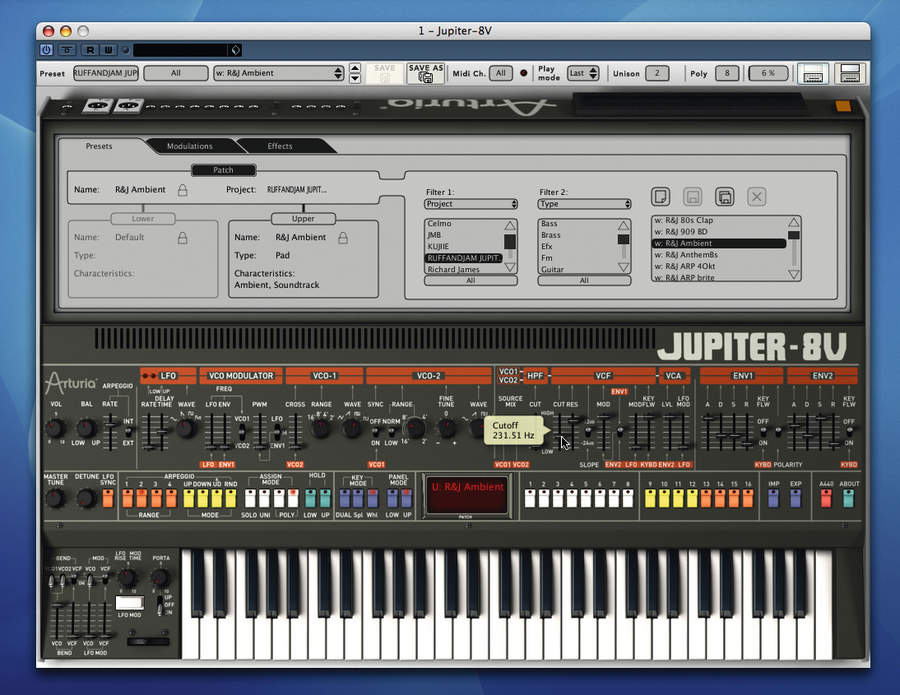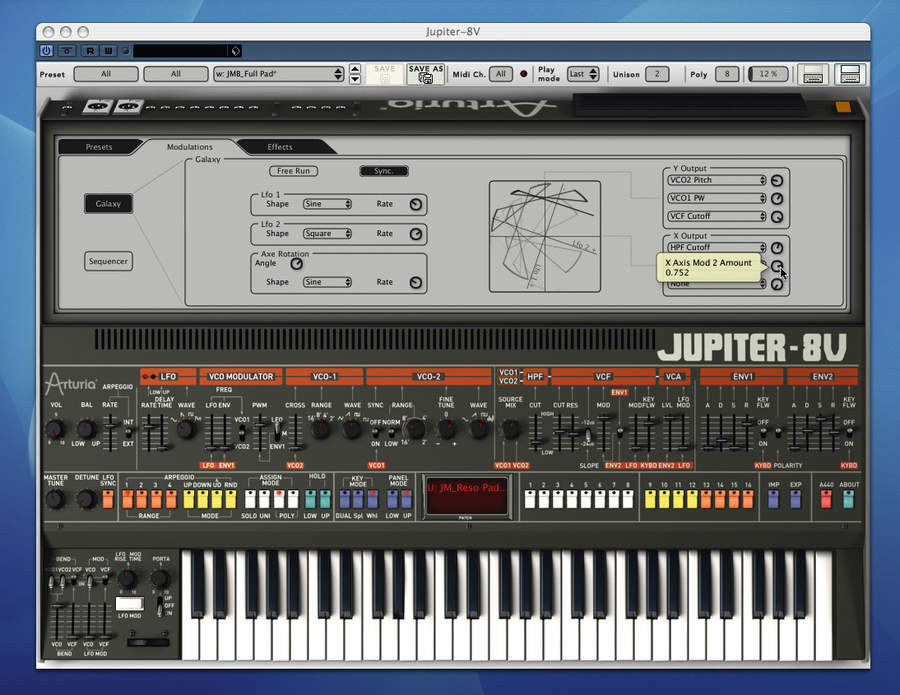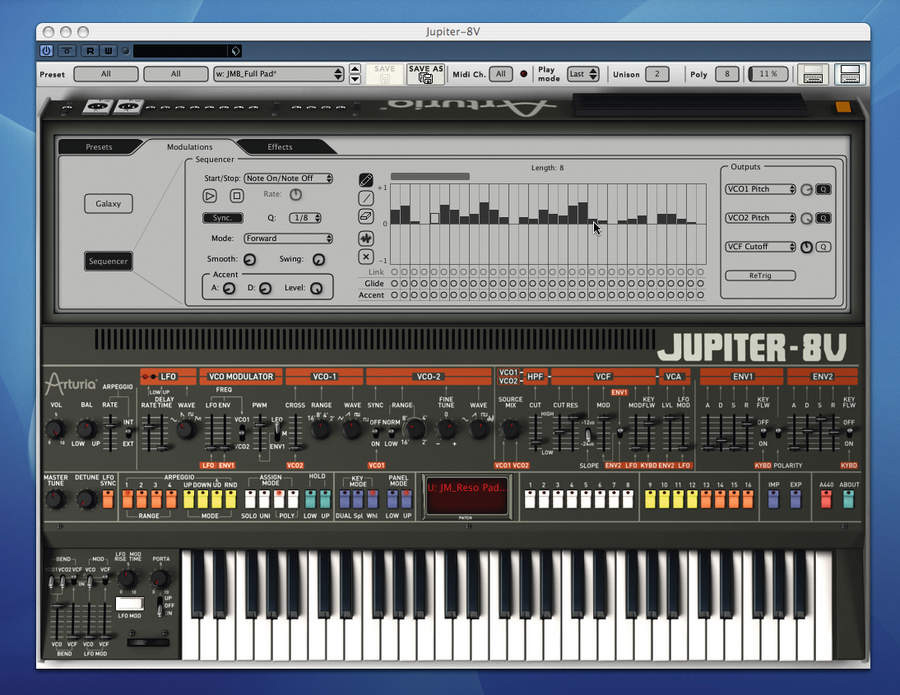MusicRadar Verdict
This one is right on the money. Jupiter-8 fans are going to love it.
Pros
- +
Big, bold sounds. Galaxy module is cosmic, man! Flexible effects processors. Easy layering of sounds Nifty built-in sequencer…
Cons
- -
Sequence length needs modulating. CPU usage is stratospheric.
MusicRadar's got your back



Synthesizer aficionados have long desired a software emulation of Roland´s classic eight-voice Jupiter-8, and the original developers actually took a sort of sideways stab at it when they released their hardware-dependent VariOS-8 a few years ago.
However, this wasn´t terribly convincing. Fortunately for us, Arturia´s offering is a different beast. The company have already made a name for themselves with some cracking software emulations of classic synths, though it should be said that a couple of their recent releases have been just a touch disappointing. With the Jupiter-8V, though, they´re firmly back on track. This synth is a cross-platform, 32-voice instrument that can be used standalone or as a plug-in. And all the major formats are supported.
On the surface, it looks much like the hardware on which it´s based. It sports a pair of oscillators per voice, a dual filter design and standard ADSR envelopes. There´s a pair of LFOs onboard and, as you would expect on a modern instrument, some built-in effects processors. An arpeggiator has been thrown in for good measure.
These features can actually be found in any number of synthesizers, but the Roland Jupiter-8 wasn´t just any synthesizer. Even polyphonic instruments were a rarity in 1981, but the Jupiter went further still by being multitimbral. It was also one of the first synths to offer splits and layers across the keyboard, and Arturia´s emulation shares this ability. This enables the creation of deep, complex sounds that can be nothing short of huge.
In fact, even if you don´t do any layering at all, the Jupiter-8V is capable of some seriously massive timbres. If these aren´t enough, you can always use the unison function. This takes you from massive to practically galactic - trance fans are going to eat this thing up.
Oscillators
So the basics are all here, but it´s the little things that make the Jupiter stand out. You´ll find cross-modulation between the oscillators, for example, and you can also sync the oscillators for those ever-popular 80s leads. VCO2 can also be switched between normal and low-frequency modes. Plus, those oscillators offer six different wave shapes between them, including noise and modulatable pulse waves.
Once you´ve selected your waves, you can mix them and send them through the dual filters. You get a 6dB non-resonant high-pass filter and a low-pass filter with a selectable slope (12 and 24dB) and a resonance slider. Neither filter self-resonates - but neither did those on the real thing. The filter can be modulated by the LFO, keyboard and Envelope 2, in both positive and negative directions.
Sounds
Simply, it´s superb. Arturia have outdone themselves with the filter. It sounds warm and alive and reacts smoothly to real-time tweaking. The Jupiter-8V´s modulation sources include the aforementioned pair of four-stage envelope generators and two LFOs, though you have to open up the Modulations page to get to the second one.
Once you have done so, you´ll gain access to the Galaxy module. This is sort of like an automated X/Y vector controller, but one in which the X and Y outputs are spun around on their axes (you can choose three destinations for each of these). The Galaxy module is an interesting and inspiring modulation source that´s a lot of fun to watch, too.
As you´d expect, there are loads of built-in effects: delays, reverbs, choruses and more. What isn´t so expected is the ability to plug effects in at various steps in the synthesis signal path; you can stick a chorus in after the oscillators but before the filters, for example. What´s more, effects can be modulated by a handful of sources, including the Galaxy module. Cool.
The Jupiter-8V is a bit special. Its sound is convincingly analogue (if a little ‘precise´), and there are enough new features to keep things interesting. We can´t say enough about the Galaxy module, and we wish all built-in effects processors were this flexible.
It isn´t perfect, though. We suffered a crash during the course of our review (though it was just the one) and then there´s the CPU consumption. On our 2.16GHz Core 2 Duo iMac it sucks up 6% of the CPU just sitting there. Playing a four-note chord can drive the CPU meter to over 26%, and you can double this for the same patch on our Athlon 64 3000+.
So, what we have here is a big synth with a big sound and a big appetite. Rest assured, though, that the Jupiter-8V is well worth the processing power. This is arguably Arturia´s best effort yet.
MusicRadar is the number 1 website for music makers of all kinds, be they guitarists, drummers, keyboard players, djs or producers...
GEAR: We help musicians find the best gear with top-ranking gear round-ups and high- quality, authoritative reviews by a wide team of highly experienced experts.
TIPS: We also provide tuition, from bite-sized tips to advanced work-outs and guidance from recognised musicians and stars.
STARS: We talk to musicians and stars about their creative processes, and the nuts and bolts of their gear and technique. We give fans an insight into the actual craft of music making that no other music website can.
“Every note counts and fits perfectly”: Kirk Hammett names his best Metallica solo – and no, it’s not One or Master Of Puppets
Ranked: Bon Iver's albums, from Sable, Fable to For Emma, Forever Ago
“Its mission is simple: unleash the power of any amplifier or line-level source without compromise”: Two Notes promises a “watershed” in tube amp control with the Torpedo Reload II










